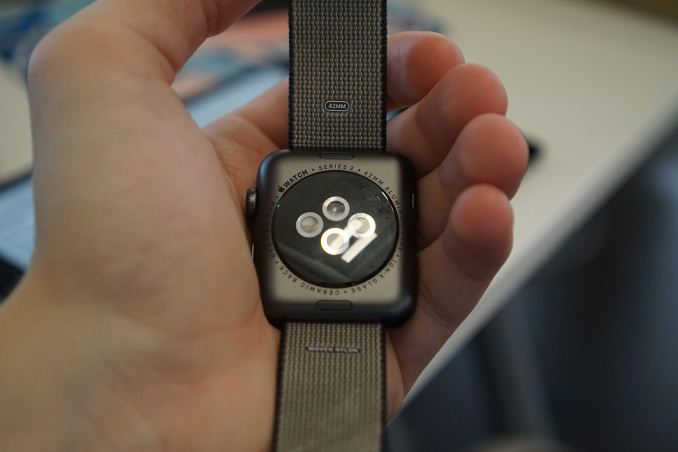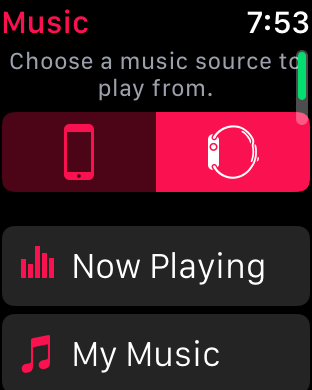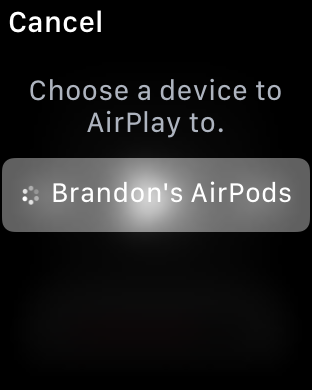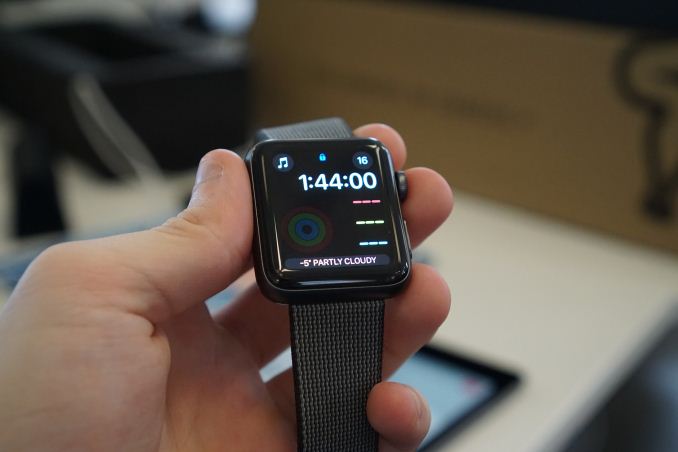The Apple Watch Series 2 Review: Building Towards Maturity
by Brandon Chester on December 20, 2016 8:00 AM EST- Posted in
- Wearables
- Apple
- Apple Watch
- Apple Watch Series 2
Final Words
In many industries, but especially in technology, there's a common wisdom about waiting for the second or third iteration of a product before purchasing it. This is based on the idea that the first version of a product will often be the most flawed or compromised - a product still trying to find its footing - and future iterations will benefit from improved technology, as well as fixes for flaws that were found in early versions. At the same time, there have to be some people who are adventurous enough to adopt bleeding-edge technology, or the first version of a product would simply fail in the market and there wouldn't ever be a second version.
This situation has played out for every iOS and iOS-derived device that Apple has created. The original iPhone was quite a technological marvel, but it was crippled by its lack of 3G networking, and its price was exceptionally high. With the iPhone 3G and 3GS, Apple addressed many of the issues that existed with the iPhone 2G, and by the time of the iPhone 4 the refinement was essentially at the same level that we expect from smartphones today. The original iPad was an interesting idea, but it was quick thick and heavy, and the hardware used at the time was not up to the task of powering such a device, sending it to end of life status after only two major updates. Only one year later, the iPad 2 addressed both of these issues, future versions brought faster hardware and higher resolution displays, and by the time of the iPad Air it reached a level of refinement where further versions have been much more iterative changes.
The first Apple Watch was definitely in the same situation as the iPhone 2G and the iPad 1. It was the first version of a brand new product, bound by serious hardware limitations and many unknowns about how consumers would come to use it. Like the iPad 1 it has received two major OS updates, and I don't expect it to go any farther. I talked earlier about how Apple had an idea of how the Apple Watch would be used, but clearly overestimated the appeal of some aspects and underestimated the appeal of others. The Apple Watch Series 2 focuses more on these aspects such as fitness with its GPS and true waterproofing, while watchOS 3 fixes many of the software issues that existed in the previous two versions.
The Apple Watch is still very much a companion to the iPhone. Even with the addition of GPS, it isn't close to being able to stand on its own. You can avoid bringing along the paired iPhone for workouts, and the watch can pull data from the network in some cases using its built in WiFi, but in general having the iPhone nearby is a requirement to actually do anything. Bringing cellular to the Watch would make it significantly less-dependent on the iPhone, but that also comes with a power and a space penalty, both of which are heavily constrained with a smartwatch.
Even if Apple were to bring cellular to the Apple Watch, I question how beneficial it would be for the experience given the two drawbacks I mentioned above. I can't think of many cases where I don't actually have my phone, so I don't know why I'd pay to maintain an additional cellular line for my watch when my phone was usually available to handle network activity. Additionally, adding cellular wouldn't remove the tight connection between the two devices, as the Apple Watch's settings and backups exist on the paired iPhone, and all of its applications are extensions of iPhone apps. This model makes it clear to me that Apple isn't planning to make the Apple Watch a standalone device any time soon.
As a companion to the iPhone, the Apple Watch works quite well. For me the Apple Watch is a timepiece, a hub for relevant information and notifications, a music player, and a health and fitness tracker. I've long since gotten used to having something on my wrist, and in fact I find myself checking my bare wrist out of habit when I've taken the Apple Watch off. Being able to check the time, the weather, the date, and other information simply by raising your wrist is just a convenience, and it's nothing your iPhone can't do as well, but it's a convenience that I wouldn't want to give up now that I have it.
Using Apple Watch as a music player is probably a more niche use case, but it does apply to me. It really seems like the natural replacement of the current iPod Nano, which is of a similar size. Of course, there's no headphone jack, but I've been using Bluetooth headphones for seven years so that doesn't present a problem for me personally. Even if you use your iPhone for music, the Apple Watch provides a quick way to access playback controls, especially if you have the Music application set as a complication or kept in the Dock. I suspect that more users will end up utilizing the standalone Music playback abilities of the Apple Watch now that the AirPods are shipping to consumers, but only time will tell.
Last, but not least, are the Apple Watch's health and fitness tracking abilities. When the Apple Watch first launched I thought I would just turn these off and forget about them, but my own poor health choices have led to me relying on them to keep myself on track. Having something constantly monitoring me is essential in figuring out how many calories I'm burning on a daily basis, which is how I decide what I'm going to eat. Workouts also provide me with various statistics about my jogging and cycling that I had always wondered about but had never been able to track. As the days get colder, having the Activity rings on the watch face is also a constant reminder that I need to keep active even if I'm staying inside to keep warm. Many of these things basically come down to the Apple Watch pointing out flaws in my personality that I won't improve of my own volition, and I'm okay with that because it produces results.
While I'm talking about the core aspects of the current Apple Watch experience, it does bear repeating that some things that Apple thought would be a big part of the experience have really fizzled out. I haven't found myself using it as a communication device except for taking phone calls, and Apple has de-emphasized communication as a feature in watchOS 3 accordingly, so I expect I wasn't alone. Similarly, I think issues with watchOS and the original Apple Watch's hardware have damaged the image of the Apple Watch as an app platform, and as someone who used the original I really haven't gotten used to using applications because in the past they just never worked.
As for development, I think it's fair to say that the Apple Watch hasn't yet proven itself as a developer platform. However, WatchKit is a really interesting and well thought out API for designing and developing apps for the smartwatch form factor. Despite the quality of the API itself, there's clearly still uncertainty over what an Apple Watch app should even aspire to do. I think not making a watchOS app at all is a valid decision for many iPhone applications, and that's an important decision for developers to make because it's an investment of time and money, and there are several applications that offer watchOS apps without any compelling functionality.
Ultimately, both watchOS and the Apple Watch are still in their early days, and the software will grow and improve over time as the hardware becomes faster and more efficient. The Apple Watch Series 2 really reminds me of the iPad 2. It tackles the areas where its predecessor faltered, and provides a much better experience as a result, but there's still that lingering early adopter feeling that even greater improvements are coming in the next generation. I would imagine that future series of the Apple Watch will bring additional sensors for tracking health information, thinner casings, and hopefully better battery life so features like sleep tracking will be possible. While there's always something to look forward to in future versions of a product, I think the Apple Watch Series 2 does provide a compelling experience right now, and for iPhone users interested in a fitness tracker or a smartwatch it should be high on your list of devices to consider.















126 Comments
View All Comments
ddriver - Tuesday, December 20, 2016 - link
It has got to be the shortest lived fad so far.name99 - Tuesday, December 20, 2016 - link
And IMHO you have no idea what you are talking about. This is EXACTLY the same as the nonsense we heard when the iPhone came out: "why do I want a phone that can run a browser when my PC has a bigger screen? my feature phone already runs apps fine. and it's sooo expensive".If you haven't used an aWatch you don't have a right to comment on it, it's that simple.
Brandon actually left out a huge number of use cases.
- He left out Siri -- I frequently use this especially for reminders "when I get home, remind me to pick up the alcohol swabs", "add soy milk to list Costco", "how many grams is 3.5 ounces".
- He left out notifications which again are really nice on the wrist.
- I have five different watch faces: sleepytime which tracks my sleep and uses big red numbers so less sharp when I see it in the dark; everyday which is dense with info - time, date (tap to get today's calendar events), weather, activity rings (small) next alarm, time in one other time zone; workout --- big activity rings, heart rate, button to get to workout app, battery left; space and time which allows easy access to Maps, where my friends are (Find my Friends) , and HomeKit control; and Photos (random photos of adorable baby animals that make my smile every time I see them).
I swipe between all of these every day.
In the dock I have "Now Press Record" which records what it hears and stores it to the cloud --- ready in case I have an encounter with police or other bolshy authority. Next is the audio controller app. (Unfortunately the one BIG missing feature on aWatch today is decent handling of audiobooks as opposed to just music. Hopefully in WatchOS4 ...) Next the Nest Camera app. It doesn't do much (in particular it does NOT send you a snapshot of what the camera is seeing) but it DOES allow you very easily and quickly to validate that the camera is correctly armed when you expected it to be. Next Automatic (just gives direction to where you parked, but that's all you want on the wrist). Next Homekit which I, for now, primarily use to check out the temperature in my bedroom.
Some other subtleties the article missed. In addition to replying to texts via voice, you can also write one letter at a time. This might sound dumb but is occasionally useful for a short reply that needs to be exact. (Like giving a price or a time.) And with WatchOS 3 and Series 2 the device FEELS delightful in a way that Series 0 did not because the performance just wasn't there.
Oh and Apple Pay is really convenient (modulo the on-going stores too stupid or too cheap to support wireless payments).
It's not all perfect. The one HUGE case that doesn't work well is if you want to go on an outdoor walk/run to somewhere you don't know, so you want both Maps and Workout to be active simultaneously. In this case both apps want to control the screen, there's no ideal way to flip between them and in one case their fighting landed up wedging my watch (that was with an older version of the OS so hopefully it's fixed now). There seems room for at least some special-case intelligence here to appreciate that this is a common situation and to handle it better.
As for how well they are doing, like other commenters on the internet, I'm starting to see them more and more. For the first year I never saw one in the wild, now I see one at least once a week, on the wrists of people like cashiers or waiters.
negusp - Tuesday, December 20, 2016 - link
But for $400? I made my argument against premium priced wearables.fanofanand - Wednesday, December 21, 2016 - link
"If you haven't used an aWatch you don't have a right to comment on it, it's that simple."Interesting logic. So nobody is allowed to have an opinion about anything they don't personally own or haven't experienced? I suggest you start out by telling all of the protesters who were never in a war that they don't have the right to an opinion. To all the folks protesting police for questionable behavior, if they haven't personally been shot then they have no right to an opinion. If you don't own a 2014 Ford Mustang, you have no right to have an opinion on it. To all the vegans who think meat is murder, if they've never had a steak they have no right to their opinion.
Simple as that.
monopodman - Friday, December 23, 2016 - link
A world would definitely be a better place with fewer opinions from people who have no idea. But yeah, that's just a dream.MonkeyPaw - Tuesday, December 20, 2016 - link
I bought a Series one for $190 on Black Friday. I like it quite a bit for that price, and I've tried other bands as well. I like that I can keep my phone on silent all day long, and I don't even have to dig it out of my pocket (or even have it on me) for many things. It's also compatible with my work's Outlook setup, so I have my calendar events right on the face. Having an extra motivator to be active is nice as well.I get that these aren't for everyone, and I think $400 is too much, but I like the Apple Watch for what I use it for.
amdwilliam1985 - Tuesday, December 20, 2016 - link
my wife just got a XiaoMi fit 2 for $200HKD.It got like close to 1 month of battery life(wtf), tells time, heart time, sleep tracking, vibrate with phone call and notification.
Midwayman - Wednesday, December 21, 2016 - link
I don't have an issue paying $400 for a watch. I have plenty of those. They even do far less. The real issue is the lifespan. I can expect decades out of a quality traditional watch. A smartwatch I'm probably lucky if it lasts 3 years between battery issues and plain getting outdated. Its just another fairly large recurring cost. You have to pick and choose which tech products are worth keeping up with I guess.jaydee - Wednesday, December 21, 2016 - link
It's all about Apple trying to convince you that your time an effort is such a valuable commodity, that you have to buy a $400 device to do 20% of what your $800 iPhone can do, just by looking at your wrist instead of the arduous and back-breaking task of pulling something out of your pocket.Hence Brandon's comment in the article:
"Being able to check the time, the weather, the date, and other information simply by raising your wrist is just a convenience, and it's nothing your iPhone can't do as well, but it's a convenience that I wouldn't want to give up now that I have it."
KoolAidMan1 - Thursday, December 22, 2016 - link
I see wearables everywhere now. The most common are Apple Watches and Fitbits.